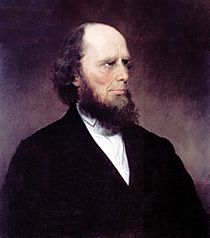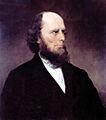Charles Grandison Finney facts for kids
Quick facts for kids
Charles Grandison Finney
|
|
|---|---|
 |
|
| 2nd President of Oberlin College | |
| In office 1851–1866 |
|
| Preceded by | Asa Mahan |
| Succeeded by | James Fairchild |
| Personal details | |
| Born | August 29, 1792 Warren, Connecticut, U.S. |
| Died | August 16, 1875 (aged 82) Oberlin, Ohio, U.S. |
| Spouses | Lydia Root Andrews (m. 1824) Elizabeth Ford Atkinson (m. 1848) Rebecca Allen Rayl (m. 1865) |
| Profession | Presbyterian minister; evangelist; revivalist; author |
| Signature | |
Charles Grandison Finney (born August 29, 1792 – died August 16, 1875) was an important American Presbyterian minister. He was a big leader during a time of religious excitement called the Second Great Awakening in the United States. Many people called him the "Father of Old Revivalism" because of his powerful preaching. Finney believed that people had complete free will to choose their own path to salvation. This idea was different from some older religious teachings.
Finney was famous for his energetic preaching from 1825 to 1835. He preached in places like Upstate New York and Manhattan. He also believed strongly in Christian perfectionism, which meant trying to live a very good Christian life. His religious beliefs led him to support important social changes. He worked for abolitionism, which was the movement to end slavery. He also pushed for equal education for women and African Americans. From 1835, he taught at Oberlin College in Ohio. This college was special because it welcomed students of all races and genders. He later became the college's second president from 1851 to 1865. The students and teachers at Oberlin were very active in fighting against slavery. They also helped people escape slavery through the Underground Railroad.
Contents
Early Life and Calling
Charles Finney was born in Warren, Connecticut, on August 29, 1792. He was the youngest of nine children. His family were farmers who moved to a new area in Jefferson County, New York, after the American Revolutionary War. Charles never went to college. However, he was a natural leader. He was tall, good at music, and had very striking eyes. These qualities made him well-known in his community.
He and his family went to the Baptist church in Henderson, New York. The preacher there led very emotional meetings that inspired people. In the early 1800s, Baptists and Methodists were known for their strong religious feelings. Finney first studied to become a lawyer. He worked as an apprentice under Benjamin Wright. Later, in Adams, New York, he joined the church of George Washington Gale. He even became the director of the church choir. After a powerful religious experience, he decided to stop practicing law and become a preacher.
When he was young, Finney was a Master Mason. But after his religious conversion, he left the group. He felt it was against Christian beliefs and became active in movements against Freemasonry.
In 1821, Finney began studying to become a minister in the Presbyterian Church. He studied with George Washington Gale. Finney moved with Gale to a farm in Western, New York, and worked there in exchange for lessons. This was an early idea for Gale's Oneida Institute. Finney had some doubts about certain traditional Presbyterian teachings. In 1832, he moved to New York City. There, he was a minister at the Chatham Street Chapel. He made a bold decision to not allow slave owners or traders to take part in Communion. Since the Chatham Street Chapel was a theater used as a church, a new building was made for him in 1836. This new church, the Broadway Tabernacle, was the largest Protestant church in the country at the time. In 1835, he became a professor at the new Oberlin Collegiate Institute in Oberlin, Ohio.
Powerful Revivals
Finney was a very active revivalist preacher from 1825 to 1835. He worked in Jefferson County and later in Manhattan. In 1830 and 1831, he led a famous revival in Rochester, New York. This event inspired many other revivals during the Second Great Awakening. A pastor in New York, who became a Christian during the Rochester meetings, described the impact of Finney's work. He said, "The whole community was stirred. Religion was the topic of conversation everywhere." He also noted that the city's only theater became a stable, and the circus became a factory. Bars closed, and churches were full of happy worshippers. People became more generous and wanted to do good things.
Finney was known for new ways of preaching and leading religious meetings. These methods often changed entire communities. For example, he allowed women to pray out loud in public meetings with men and women together. He also introduced the "anxious seat." This was a special place where people who were thinking about becoming Christians could sit to receive prayers. He was also known for speaking without notes, which is called extemporaneous preaching.
People said Finney understood how complicated human weaknesses were. He would "pour the floods of gospel love upon the audience." He found quick ways to reach people's hearts. His powerful words helped people overcome their doubts. Some of Finney's followers included Theodore Dwight Weld, John Humphrey Noyes, and Andrew Leete Stone.
Fighting Against Slavery
Besides being a popular Christian evangelist, Finney was deeply involved in social changes. He especially supported the abolitionist movement, which aimed to end slavery. Finney often spoke out against slavery from his church pulpit. He called it a "great national sin." He even refused to give Holy Communion to people who owned slaves.
President of Oberlin College
In 1835, a rich silk merchant named Arthur Tappan offered money to the new Oberlin Collegiate Institute. He suggested that Finney should start its theology department. After much discussion, Finney agreed. But he had some conditions. He wanted to keep preaching in New York. He also insisted that the school must accept Black students. And he wanted to make sure that free speech was allowed at Oberlin.
More than ten years later, Finney became the college's second president. He served from 1851 to 1866. He had also been acting president in 1849. Oberlin was the first American college to accept women and Black students, in addition to white men. From its early days, the teachers and students at Oberlin were very active in the abolitionist movement. They worked with people from the town to help enslaved people escape. They were part of the Underground Railroad. They also resisted the Fugitive Slave Act, which made it harder for enslaved people to gain freedom. Many enslaved people escaped to Ohio from Kentucky. This made Ohio a very important place for their journey to freedom.
Personal Life
Charles Finney was married three times. His first wife was Lydia Root Andrews (1804–1847). They married in 1824 and had six children. After Lydia passed away, he married Elizabeth Ford Atkinson (1799–1863) in Ohio in 1848. In 1865, he married Rebecca Allen Rayl (1824–1907), also in Ohio. All three of Finney's wives traveled with him on his preaching tours. They also helped him in his efforts to spread his religious message.
Finney's great-grandson, who was also named Charles Grandison Finney, became a well-known author.
Images for kids
See also
 In Spanish: Charles Finney para niños
In Spanish: Charles Finney para niños


